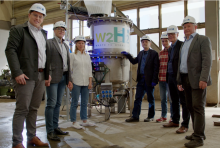Date added: 2022-12-13
Eco-friendly transport and efficient waste utilization
A pyrolyzer is a reactor which decomposes complex hydrocarbon materials into simple elements and compounds in an anaerobic annealing process at high temperatures. Pyrolysis of waste, using the technology developed at Gdańsk Tech, results in production of syngas which contains, among others, methane, carbon monoxide and a very large amount of hydrogen. Subsequently, syngas goes through separation process, which results in obtaining one of the most desirable sources of green energy, i.e. pure hydrogen. The process also results in obtaining biochar containing 60-80% pure carbon, which can be used for heating purposes or in many other technological processes.
– In Poland, we "produce" millions of tons of waste that cannot be reused. Our original technology allows for a very efficient and inexpensive recovery of the energy contained in hydrocarbon waste. Thanks to the innovative design, the reduction of complex hydrocarbons to basic elements and simple compounds takes place already in the reactor. As a result, we obtain pure syngas from the reactor with a composition of up to 50% hydrogen, approximately 25% carbon monoxide, approximately 15% methane and approximately 10% carbon dioxide, without having to use many expensive filters, and with the highest efficiency – explains Prof. Bogusław Kusz.
Waste utilization, ecological fuel
The technology developed at Gdańsk Tech by a research team from the Faculty of Applied Physics and Mathematics, is characterized by a strong concern for environmental protection, simultaneously providing a viable alternative to obtaining conventional fossil fuels.
– After using the PSA method, we can obtain hydrogen from syngas, pure sufficiently for application in e.g. urban buses. The biochar formed during the pyrolysis process contains mainly porous carbon, while its absorption and catalytic properties can be used in purification processes, or used as a solid fuel. In conclusion, we propose a technology which can provide ecological transportation and efficient heating from waste – emphasizes Prof. Kusz.
The technology obtained a patent in Poland (PAT. No. 241665) and was filed for a patent in the international procedure.
License agreement with W2H2
The company was established on the basis of technology from Gdańsk University of Technology. The CEO of 4E Energy – Wojciech Białecki – became the chairman of W2H2. The company participated in the study of the municipal and industrial waste pyrolysis process at the stage of verifying the business potential of the invention with Gdańsk Tech.
– The key, short-term goal of W2H2, is to build a pilot plant with a partner from waste or energy industry. Ultimately, we plan to become a supplier of industrial hydrogen production equipment. We plan to expand into European and global markets. We care for the advantages of the partnership with Gdańsk University of Technology, while developing our company – comments Wojciech Białecki.
The following persons worked on the preparation and negotiation of the terms of the license agreement at Gdańsk University of Technology: Sławomir Ćwikliński from the Center for Knowledge and Technology Transfer, Legal Counsel Joanna Ratasiewicz from the Legal Counsel Office and Patent Attorney, Justyna Pawłowska from the Patent Attorneys Office.
From a research project to a spin-off
The concept of establishing a spin-off company based on the reactor design and pyrolysis technology developed at WFTiMS, was the result of the cooperation with Gdańsk Tech Center for Technology Transfer. Based on the analyses of the project and conducted discussions with potential business partners, the innovation broker planned a comprehensive strategy for commercialization of the technology, which resulted in the establishment of a company in cooperation with the authors of the invention.
In the first stage, the design and properties of the pyrolyzer were tested using funds from the Innovation Incubator 4.0. After obtaining promising results from the research conducted in cooperation with GSC Sp. z o.o. sp. k., it was decided to file the solution for protection in the international patent procedure using funds form Titanium program. The following step was the establishment of a spin-off company. The researchers decided to establish W2H2 company together with Excento sp. z.o.o., the special purpose entity established by Gdansk University of Technology.
In the process of developing the pyrolysis technology, Professor Kusz and Bartosz Trawiński, PhD, filed 3 new invention applications. One element of the pyrolyzer design is currently being refined, using funding from the Innovation 4.0 Incubator. It is a feeder that can be used independently of the reactor, in equipment where it is necessary to move materials between two zones with different pressure, temperature, and, above all, composition of the atmosphere.


